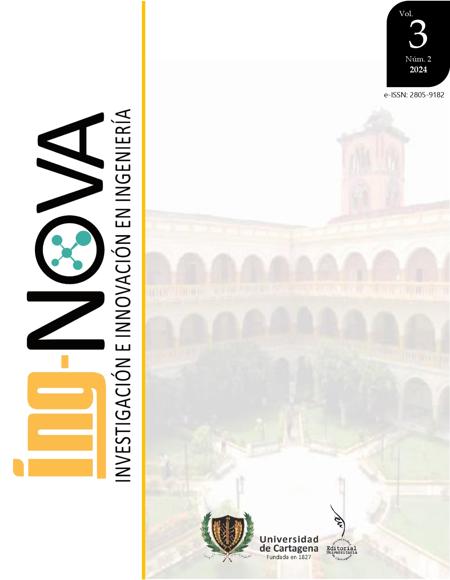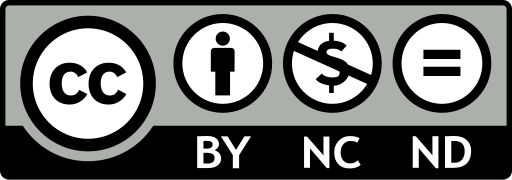Aproximación bidimensional P1 (P1-2D) para la descripción del campo radiante en reactores solares fotocatalíticos cilíndricos
Two-dimensional P1 approximation (P1-2D) for the Description of the Radiant Field on Cylindrical Solar Photocatalytic Reactors
Contenido principal del artículo
Resumen
Se formuló la velocidad volumétrica local de absorción de fotones (LVRPA) resolviendo la Ecuación de Transferencia Radiativa (RTE) en coordenadas polares con la aproximación P1 (P1-2D) para la descripción del campo radiante en reactores solares fotocatalíticos cilíndricos. Se formuló una expresión general del LVRPA que puede emplearse en reactores fotocatalíticos cilíndricos con una radiación incidente constante a lo largo de la longitud del reactor. Se utilizaron reactores fotocatalíticos CPC y tabulares como modelos de reactor y se consideró la ley del coseno de Lambert (irradiancia) al utilizar las condiciones de contorno. Las simulaciones se realizaron utilizando el TiO2-P25 comercial cuyas propiedades ópticas se tomaron de la bibliografía. Se encontró que el LVRPA disminuye exponencialmente desde la pared del reactor hacia su centro. La velocidad volumétrica de absorción de fotones por unidad de longitud del reactor (VRPA/H) aumentó exponencialmente con la carga de catalizador hasta un valor en el que no se observó un aumento significativo y se encontró que aumentaba con el radio del reactor, información que concuerda con la literatura. La carga óptima de catalizador con el reactor CPC fue de aproximadamente 0,364 g/L con un radio del reactor igual a 1,65 cm, similar a la encontrada en la literatura cuando se utilizó el modelo de seis flujos en dos dimensiones (SFM-2D). El espesor óptico aparente τ_App1 formulado de nuevo con la aproximación P1 se introdujo con fines de optimización y se encontró más fiable que el espesor óptico τ. Este parámetro no sólo elimina la dependencia de la carga óptima de catalizador del radio del reactor, sino también su dependencia del albedo del catalizador. El τ_App1 se encontró alrededor de 9,73 y 14,6 para CPC y reactores tubulares, respectivamente, y proporciona la carga óptima de catalizador y el radio del reactor que optimizan la absorción de radiación dentro de ambos reactores
Palabras clave
Descargas
Datos de publicación
Perfil evaluadores/as N/D
Declaraciones de autoría
Indexado en
- Sociedad académica
- Universidad de Cartagena
- Editorial
- Universidad de Cartagena
Detalles del artículo
Referencias (VER)
He, C., Clifton, O., Felker-Quinn, E., Fulgham, S. R., Juncosa Calahorrano, J. F., Lombardozzi, D., Purser, G., Riches, M., Schwantes, R., Tang, W., Poulter, B., & Steiner, A. L. (2021). Interactions between Air Pollution and Terrestrial Ecosystems: Perspectives on Challenges and Future Directions. Bulletin of the American Meteorological Society, 102(3), E525– E538. https://doi.org/10.1175/BAMS-D-20-0066.1 DOI: https://doi.org/10.1175/BAMS-D-20-0066.1
Nair, A. K., & JagadeeshBabu, P. E. (2017). Ag-TiO2 nanosheet embedded photocatalytic membrane for solar water treatment. Journal of Environmental Chemical Engineering, 5(4), 4128–4133. https://doi.org/10.1016/j.jece.2017.07.046 DOI: https://doi.org/10.1016/j.jece.2017.07.046
Diaz-Angulo, J., Lara-Ramos, J., Mueses, M., Hernández-Ramírez, A., Li Puma, G., & Machuca-Martínez, F. (2020). Enhancement of the oxidative removal of diclofenac and of the TiO2 rate of photon absorption in dye-sensitized solar pilot scale CPC photocatalytic reactors. Chemical Engineering Journal, 381, 122520. https://doi.org/10.1016/j.cej.2019.122520 DOI: https://doi.org/10.1016/j.cej.2019.122520
Rizzo, L., Malato, S., Antakyali, D., Beretsou, V. G., Đolić, M. B., Gernjak, W., Heath, E., Ivancev-Tumbas, I., Karaolia, P., Lado Ribeiro, A. R., Mascolo, G., McArdell, C. S., Schaar, H., Silva, A. M. T., & Fatta-Kassinos, D. (2019). Consolidated vs new advanced treatment methods for the removal of contaminants of emerging concern from urban wastewater. Science of The Total Environment, 655, 986–1008. https://doi.org/10.1016/j.scitotenv.2018.11.265 DOI: https://doi.org/10.1016/j.scitotenv.2018.11.265
Vaya, D., & Surolia, P. K. (2020). Semiconductor based photocatalytic degradation of pesticides: An overview. Environmental Technology & Innovation, 20, 101128. https://doi.org/10.1016/j.eti.2020.101128 DOI: https://doi.org/10.1016/j.eti.2020.101128
Wang, D., Mueses, M. A., Márquez, J. A. C., Machuca-Martínez, F., Grčić, I., Peralta Muniz Moreira, R., & Li Puma, G. (2021). Engineering and modeling perspectives on photocatalytic reactors for water treatment. Water Research, 202, 117421. https://doi.org/10.1016/j.watres.2021.117421 DOI: https://doi.org/10.1016/j.watres.2021.117421
Ochoa-Gutiérrez, K. S., Tabares-Aguilar, E., Mueses, M. Á., Machuca-Martínez, F., & Li Puma, G. (2018). A Novel Prototype Offset Multi Tubular Photoreactor (OMTP) for solar photocatalytic degradation of water contaminants. Chemical Engineering Journal, 341, 628–638. https://doi.org/10.1016/j.cej.2018.02.068 DOI: https://doi.org/10.1016/j.cej.2018.02.068
Colina-Márquez, J., Machuca-Martínez, F., & Li Puma, G. (2015). Modeling the Photocatalytic Mineralization in Water of Commercial Formulation of Estrogens 17-β Estradiol (E2) and Nomegestrol Acetate in Contraceptive Pills in a Solar Powered Compound Parabolic Collector. Molecules, 20(7), 13354–13373. https://doi.org/10.3390/molecules200713354 DOI: https://doi.org/10.3390/molecules200713354
Illi, E., Bouanani, F. E., Park, K.-H., Ayoub, F., & Alouini, M.-S. (2019). An Improved Accurate Solver for the Time-Dependent RTE in Underwater Optical Wireless Communications. IEEE Access, 7, 96478–96494. https://doi.org/10.1109/ACCESS.2019.2929122 DOI: https://doi.org/10.1109/ACCESS.2019.2929122
Fujii, H., Terabayashi, I., Aoki, T., Inoue, Y., Na, H., Kobayashi, K., & Watanabe, M. (2022). Numerical Study of Near-Infrared Light Propagation in Aqueous Alumina Suspensions Using the Steady-State Radiative Transfer Equation and Dependent Scattering Theory. Applied Sciences, 12(3), 1190. https://doi.org/10.3390/app12031190 DOI: https://doi.org/10.3390/app12031190
Ghafoori, S., Nasirian, M., Al-Jamal, R., Mallouh, F. A., & Mehrvar, M. (2020). Statistical parameter optimization and modeling of photodegradation of methyl orange using a composite photocatalyst prepared by thermal synthesis. Environmental Science and Pollution Research, 27(36), 45650–45660. https://doi.org/10.1007/s11356-020-10301-5 DOI: https://doi.org/10.1007/s11356-020-10301-5
Howell, J. R., Mengüç, M. P., Daun, K. J., & Siegel, R. (2021). Thermal radiation heat transfer (Seventh edition). CRC Press /Taylor & Francis Group, Boca Raton, FL (USA), 53-93. DOI: https://doi.org/10.1201/9780429327308-2
Acosta-Herazo, R., Cañaveral-Velásquez, B., Pérez-Giraldo, K., Mueses, M. A., Pinzón-Cárdenas, M. H., & Machuca-Martínez, F. (2020). A MATLAB-Based Application for Modeling and Simulation of Solar Slurry Photocatalytic Reactors for Environmental Applications. Water, 12(8), 2196. https://doi.org/10.3390/w12082196 DOI: https://doi.org/10.3390/w12082196
Moreno-SanSegundo, J., Casado, C., & Marugán, J. (2020). Enhanced numerical simulation of photocatalytic reactors with an improved solver for the radiative transfer equation. Chemical Engineering Journal, 388, 124183. https://doi.org/10.1016/j.cej.2020.124183 DOI: https://doi.org/10.1016/j.cej.2020.124183
Peralta Muniz Moreira, R., & Li Puma, G. (2021). Multiphysics Computational Fluid-Dynamics (CFD) Modeling of Annular Photocatalytic Reactors by the Discrete Ordinates Method (DOM) and the Six-Flux Model (SFM) and Evaluation of the Contaminant Intrinsic Kinetics Constants. Catalysis Today, 361, 77–84. https://doi.org/10.1016/j.cattod.2020.01.012 DOI: https://doi.org/10.1016/j.cattod.2020.01.012
Arancibia-Bulnes, C. A., Jiménez, A. E., & Estrada, C. A. (2009). Development and Modeling of Solar Photocatalytic Reactors. In Advances in Chemical Engineering (Vol. 36, pp. 185– 227). Elsevier. https://doi.org/10.1016/S0065-2377(09)00406-2 DOI: https://doi.org/10.1016/S0065-2377(09)00406-2
Cuevas, S. A., Arancibia-Bulnes, C. A., & Serrano, B. (2007). Radiation Field in an Annular Photocatalytic Reactor by the P1 Approximation. International Journal of Chemical Reactor Engineering, 5(1). https://doi.org/10.2202/1542-6580.1589 DOI: https://doi.org/10.2202/1542-6580.1589
Akdemir, O., Lagendijk, A., & Vos, W. L. (2022). Breakdown of light transport models in photonic scattering slabs with strong absorption and anisotropy. Physical Review A, 105(3), 033517. https://doi.org/10.1103/PhysRevA.105.033517 DOI: https://doi.org/10.1103/PhysRevA.105.033517
Christenson, J. G., Austin, R. A., & Phillips, R. J. (2018). Comparison of approximate solutions to the phonon Boltzmann transport equation with the relaxation time approximation: Spherical harmonics expansions and the discrete ordinates method. Journal of Applied Physics, 123(17), 174304. https://doi.org/10.1063/1.5022182 DOI: https://doi.org/10.1063/1.5022182
Harel, R., Burov, S., & Heizler, S. I. (2021). Asymptotic PN Approximation in Radiative Transfer Problems. Journal of Computational and Theoretical Transport, 50(5), 390–406. https://doi.org/10.1080/23324309.2020.1845738 DOI: https://doi.org/10.1080/23324309.2020.1845738
Cuevas, S. A., & Arancibia-Bulnes, C. A. (n.d.). Modeling UV radiation absorption in a flat-plate photocatalytic reactor.
Abdel-Maksoud, Y., Imam, E., & Ramadan, A. (2016). TiO2 Solar Photocatalytic Reactor Systems: Selection of Reactor Design for Scale-up and Commercialization—Analytical Review. Catalysts, 6(9), 138. https://doi.org/10.3390/catal6090138 DOI: https://doi.org/10.3390/catal6090138
Muscetta, M., Ganguly, P., & Clarizia, L. (2024). Solar-powered photocatalysis in water purification: Applications and commercialization challenges. Journal of Environmental Chemical Engineering, 12(3), 113073. https://doi.org/10.1016/j.jece.2024.113073 DOI: https://doi.org/10.1016/j.jece.2024.113073
Colina-Márquez, J., Machuca-Martínez, F., & Puma, G. L. (2010). Radiation Absorption and Optimization of Solar Photocatalytic Reactors for Environmental Applications. Environmental Science & Technology, 44(13), 5112–5120. https://doi.org/10.1021/es100130h DOI: https://doi.org/10.1021/es100130h
Nchikou, C., Loredo-Medrano, J. Á., Hernández-Ramírez, A., Colina-Marquez, J. Á., & Mueses, M. Á. (2021). Estimation of the radiation field for CPC photocatalytic reactors using a novel six-flux model in two dimensions (SFM-2D). Journal of Environmental Chemical Engineering, 9(6), 106392. https://doi.org/10.1016/j.jece.2021.106392 DOI: https://doi.org/10.1016/j.jece.2021.106392
Ren, Y., Zhao, L., Jing, D., & Guo, L. (2016). Investigation and modeling of CPC-based tubular photocatalytic reactor for scaled-up hydrogen production. International Journal of Hydrogen Energy, 41(36), 16019–16031. https://doi.org/10.1016/j.ijhydene.2016.04.225 DOI: https://doi.org/10.1016/j.ijhydene.2016.04.225
Reifsnyder, W. E. (1967). Radiation geometry in the measurement and interpretation of radiation balance. Agricultural Meteorology, 4(4), 255–265. https://doi.org/10.1016/0002-1571(67)90026-X DOI: https://doi.org/10.1016/0002-1571(67)90026-X
Nchikou, C. (2024). Estimation and Optimization of the Radiant Field in Flat Plate Heterogeneous Photoreactors with the P1-approximation of the Radiative Transfer Equation (RTE). Journal of the Turkish Chemical Society Section B: Chemical Engineering, 87–104. https://doi.org/10.58692/jotcsb.1450662 DOI: https://doi.org/10.58692/jotcsb.1450662
Tourasse, G., & Dumortier, D. (2014). Development of a System Measuring the Solar Radiation Spectrum in 5 Planes for Daylight and PV Applications. Energy Procedia, 57, 1110–1119. https://doi.org/10.1016/j.egypro.2014.10.071 DOI: https://doi.org/10.1016/j.egypro.2014.10.071
Marshak, R. E. (1947). Theory of the Slowing Down of Neutrons by Elastic Collision with Atomic Nuclei. Reviews of Modern Physics, 19(3), 185–238. https://doi.org/10.1103/RevModPhys.19.185 DOI: https://doi.org/10.1103/RevModPhys.19.185
Dillert, R., Cassano, A. E., Goslich, R., & Bahnemann, D. (1999). Large scale studies in solar catalytic wastewater treatment. Catalysis Today, 54(2–3), 267–282. https://doi.org/10.1016/S0920-5861(99)00188-1 DOI: https://doi.org/10.1016/S0920-5861(99)00188-1
Guillard, C., Disdier, J., Herrmann, J.-M., Lehaut, C., Chopin, T., Malato, S., & Blanco, J. (1999). Comparison of various titania samples of industrial origin in the solar photocatalytic detoxification of water containing 4-chlorophenol. Catalysis Today, 54(2–3), 217–228. https://doi.org/10.1016/S0920-5861(99)00184-4 DOI: https://doi.org/10.1016/S0920-5861(99)00184-4
Fernández-Ibáñez, P., Malato, S., & De Las Nieves, F. J. (1999). Relationship between TiO2 particle size and reactor diameter in solar photoreactors efficiency. Catalysis Today, 54(2–3), 195–204. https://doi.org/10.1016/S0920-5861(99)00182-0 DOI: https://doi.org/10.1016/S0920-5861(99)00182-0



 PDF
PDF
 FLIP
FLIP






